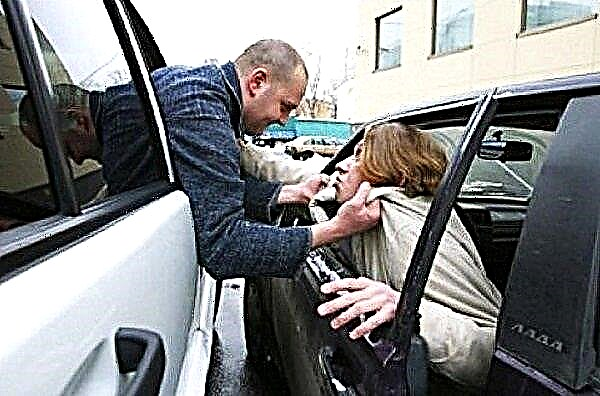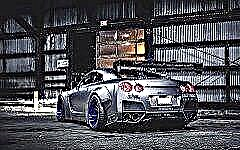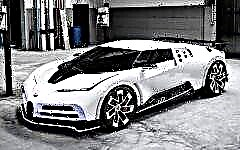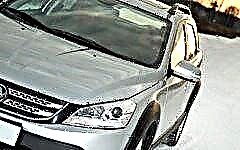
The content of the article:
- What is AutoFit
- Automotive Stand Methods
- What road bandits use to achieve their goals
- How to protect yourself from "substitutes"
Fraudsters invent anything in order to fraudulently seize the money of law-abiding citizens. But, as a rule, the scheme of withdrawing funds from them is the same. First, they choose a victim and make it so that she finds herself in a non-standard situation or becomes a participant in some kind of emergency. For example, a traffic accident. Then they make a psychological attack. Simply put, fraudsters exert moral and, in some cases, physical pressure on their victim. When the "client matures" and gives them the money, they quickly withdraw. This is how those who arrange the so-called auto-racks for beginners and inexperienced drivers do their business.
What is AutoFit

From a legal point of view, auto-fiddling is considered as a deliberate offense, the purpose of which is to extort money. It is noteworthy that according to the traffic rules, the culprit of the accident is always the motorist who crashed from behind or did not protect the "right side" from impact.
These loopholes in the rules are successfully used by bandits on the highways. In doing so, they have to resort to intimidation, threats and persuasion. In short, in one way or another, they force the victim not to contact the traffic police and insurance agent to assess the damage. A car enthusiast who finds himself in such a situation pays on the spot.
As practice shows, "substitutes" usually commit their scams on pre-selected highways.
As for the victim, first of all, road bandits are attracted by lonely motorists who are neatly dressed, neatly trimmed and, in general, have an intelligent look. After all, all these signs indicate that the owner of the car has money. Moreover, it is easier to “handle” a lonely car enthusiast.
Also, the bandits on the roads pay attention to other details:
- the presence in the back seat of bags and packages with the logo of expensive stores and boutiques (if any, the driver will be clearly solvent);
- the "U" sign located on the rear window (it is glued by novice motorists who are easier to mislead);
- a woman driving (the fairer sex is easier to intimidate, and if there is also a child in the car with her, then she becomes doubly vulnerable, and imperfect children cannot be witnesses in court);
- retired motorist (when an elderly person drives a car, then, due to his age and health, he will be initially set up for a compromise in the event of an accident, and not for a tough conflict).
At the same time, "substitutes" will never choose cars that have state numbers, special passes of state services and various veteran organizations on the windshield as a victim. It is not surprising. A car enthusiast from government agencies is a danger to fraudsters.
Also, road bandits will never pay attention to prestigious cars. After all, they are often the property of high-ranking officials, big businessmen or representatives of the criminal world.
They will not get into their field of vision and those cars on the glass of which there is a sticker of the insurance company. The fact is that if the car is insured, then no arguments of the "substitutes" will have any effect on the driver of such a car. He will calmly answer them that everything must be resolved in a legal way: collect certificates, conduct an examination, assess the damage.
The bandits on the road exclude from the number of their potential victims those motorists who demonstrate professional driving style while driving. Since this means that an experienced driver is behind the wheel, who can hardly be misled.
Inventive swindlers

Unfortunately, road gangsters regularly come up with new ways to auto-fake them. For this reason, even experienced car enthusiasts sometimes fall into their networks. However, there are several common ways that substitutes always use them. Knowing them, law-abiding drivers can save themselves from unplanned financial costs.
One of the most popular auto-fakes among scammers is the so-called "Box"... It implies that the victim is moving in the middle lane, and the "substitute" is driving in parallel along the right lane, while the "provocateur" is on the left lane. The role of the latter is assigned to an expensive car, which all drivers, without exception, fear most of all. Knowing this very well, the "provocateur" makes a sharp maneuver, twisting the steering wheel to the right, that is, towards the victim.
Naturally, the car enthusiast, in order not to collide with an expensive car, is also forced to turn the steering wheel to the right. At the same time, the "substitute" is accelerated without leaving the limits of its lane. As a result, a collision occurs. The victim's car comes into contact with the left side of the dummy car. According to the existing traffic rules, the victim will be recognized as the culprit in this accident. As for the "provocateur", he immediately adds gas and quickly leaves the scene of the accident.
An equally common type of autostop is "Sweep"... Moreover, there are many options for its implementation. However, often "substitutes" use only one of them. Anyone who plays the role of a "set-up" acts alone, without the participation of a "provocateur". He adjusts in his car from the starboard side of the selected vehicle and waits for the moment when the latter begins to change lanes to the right lane. Of course, a law-abiding driver informs other road users about his maneuver by turning on the right turn signal. This is what the "substitute" uses.
He deliberately slows down, making it clear to the victim that he is letting her into his lane. It costs nothing for a suspicious driver to start leaving his lane, as the fraudster sharply accelerates and exposes the left side of his car under attack. Usually "hooking" is done in the evening or at night, as well as in fog. In this case, the "substitute" until the moment of the accident does not turn on the lights in order to lull the victim's vigilance.
Also, bandits on the roads practice this type of auto support, such as "abstraction"... On the left side, the victim's car is caught up by the "provocateur". The latter lowers the side window on the starboard side of his car. A passenger is shown outside. With the help of various gestures, he denotes a desire to turn to the victim with some kind of request or question. Not the point is important. The main thing for him is to distract the victim from the situation on the road. Once the goal is achieved, the next car in front, driven by the "substitute", slows down sharply. A collision occurs.
However, in their scams, "substitutes" use not only machines. Sometimes they transform into pedestrians. There are a lot of ways of such setups. But they have one thing in common. They are carried out in places where traffic is difficult, and cars move at a speed that does not exceed 30 km. in ch. Such sections of roads are found near stopping points, large markets, etc.
To bring to life an autostop, which can be conventionally called "Hitting a person", "Substitutes" act according to the following scheme. A man suddenly runs out onto the roadway. Moreover, he moves sideways or with his back to the victim's car. At the same time, he is conducting a conversation on his cell phone. It is interesting that he does not create the appearance of a telephone conversation, but actually communicates.Communicates with his partner, who gives him the appropriate instructions. They concern the direction in which the "substitute" should move in order to hook his elbow on one of the side mirrors of the victim's car, and then, with a spectacular turn, fall right onto the hood.
A law-abiding car enthusiast will have no idea that under the jacket of the "substitute" there are weighty shields attached to the elbows, which are used by hockey players. Breaking a mirror with them is as easy as shelling pears. What the swindler does well. Then he informs the victim that he did not receive any injuries as a result of the fall and will not call law enforcement officials. On that and is removed.
However, an hour later, the "substitute" still calls the police and says that he was run over, and the culprit fled the scene of the accident. In order not to be unfounded, he says that there is a witness to the incident, who filmed the incident on a phone camera. Naturally, the role of the witness is played by his partner, who had previously given him instructions on his mobile. Further, the “fraudsters” can use all kinds of blackmail against the victim. In particular, they may demand compensation for injury.
There are many other ways to auto-fit. But, one way or another, they are variations of the main scam schemes.
Moreover, the bandits on the roads try not to experiment, but use already proven and effective methods. The only thing that remains for inexperienced and novice motorists is to study them well and try to avoid such situations on the road.
If a collision with a "substitute" occurred, then the drivers should remain calm and insist that traffic police officers arrive at the scene of the accident.
Professional psychologists and actors

However, even trained car enthusiasts sometimes accept the rules of the scammers' game. After all, "substitutes" are not only skillful combinators, but also professional manipulators of human consciousness. In other words, they are experienced psychologists. They know various cunning tricks with which you can put pressure on a person and force him to act in a certain way.
Also, "substitutes" are also excellent actors. Often they are presented to the victim by officials, deputies, businessmen, that is, very important and influential people who do not have time to wait for traffic police officers. And motorists willingly believe them, enter their position and immediately part with the money.
It is not uncommon for "substitutes" to perform whole performances in order to "put the squeeze on" an intractable victim.
Mobile phones are used, on which the swindlers are demonstratively loudly conducting a conversation with the alleged head of the district, regional traffic police. At the same time, they specially mention in such conversations the names of those people who really occupy high posts and positions.
Surprisingly, law enforcement agencies are aware of cases when the "substitutes" influenced their victims in a hypnotic way. This once again testifies to the fact that even motorists who have a rich driving experience behind them are not insured against autos. However, such cases are more likely an exception to the rule than a pattern.
How to protect a car enthusiast from auto-fences

In order not to become a victim of "substitutes", it is necessary to follow the rules of the road at all times. After all, breaking the rules is a real gift for a swindler.
Also, drivers are advised to stick to the rightmost lane and lane on the highway. By the way, this is what the traffic rules require. If motorists comply with this requirement, then they will not be afraid of any auto-mounts.
If, for one reason or another, the driver decided to change to another lane or lane, then he must keep the situation around his car under full control. Particular attention should be paid to the so-called "dead zones". When there is a car in such a zone, it is better to slow down and pass it forward. After all, it is possible that this is a "substitute".
Also, while driving, you should maintain a fairly large distance from other road users. In this case, you should never react to the persistent flashing of the next car behind. Perhaps this is a provocation. When the driver maneuvers to let the car pass, he may collide with a dummy car.
In short, you should behave calmly and carefully on the road. Of course, this is not a 100% guarantee that auto-fills will not happen. But, at least in this way, the driver minimizes the risk of a fake accident. And the likelihood of a real traffic accident with careful driving decreases significantly.











